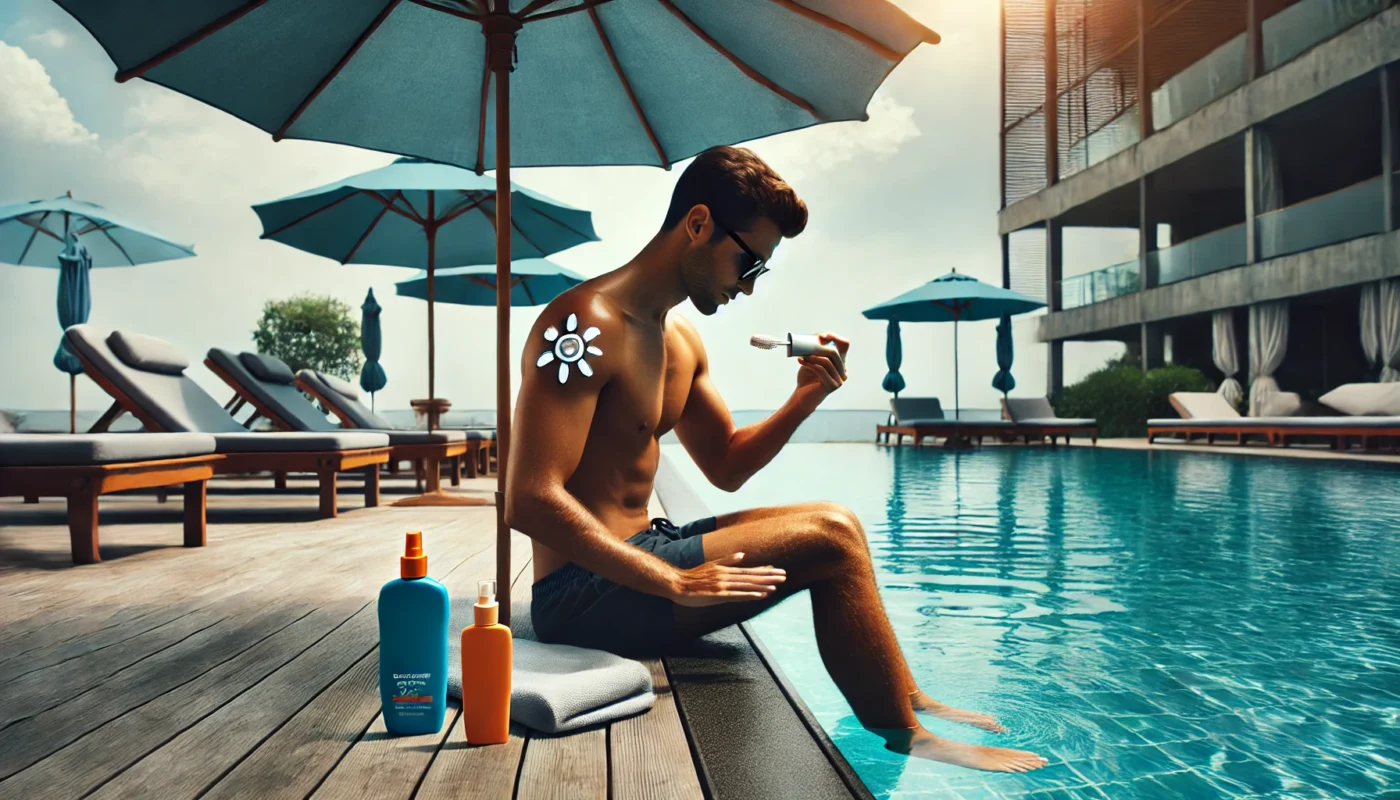When summer rolls around, one of the most delightful activities is diving into a pool or the ocean. However, with the sun at its peak, protecting your skin becomes a priority. Applying sunscreen is a crucial step before swimming, but how long should you wait before you take that plunge? In this comprehensive guide, we’ll explore the best practices for swimming post-sunscreen and ensure that your skin remains protected against harmful UV rays.
You may also like: Essential Tips for Sun Protection Daily
The Importance of Sunscreen
Sunscreen acts as a shield against the sun’s harmful ultraviolet (UV) rays, which can cause skin damage, premature aging, and increase the risk of skin cancer. While it’s essential to apply sunscreen before any outdoor activity, understanding how it interacts with water and how to maximize its effectiveness is just as crucial.
How Sunscreen Works
Sunscreens contain organic and inorganic active ingredients that absorb, scatter, or reflect UV radiation. These ingredients work together to form a protective barrier on the skin’s surface. When applied correctly, they provide a formidable defense against UV radiation. However, this protective layer can be compromised by water exposure, which is why timing your swim is key. The water can dilute the sunscreen or wash it away, reducing its effectiveness. Additionally, factors like sweat and friction can also disrupt the sunscreen layer.
Broad-Spectrum Protection
For effective protection, choose a broad-spectrum sunscreen that protects against both UVA and UVB rays. UVA rays penetrate deeply into the skin, leading to long-term damage and the formation of wrinkles and age spots. In contrast, UVB rays are primarily responsible for sunburn and can cause immediate skin damage. Both types contribute to skin cancer risk, making it imperative to select a sunscreen offering comprehensive protection. Broad-spectrum sunscreens are formulated to counteract both UVA and UVB rays, ensuring a more robust defense.
The Role of Antioxidants
Some sunscreens are formulated with antioxidants, which provide additional protection against free radicals. Free radicals are unstable molecules that can damage skin cells and accelerate aging. Antioxidants like vitamins C and E can neutralize these free radicals, offering a double layer of defense. Incorporating sunscreens with antioxidants can enhance your skin’s resilience against sun damage. This added protection can be particularly beneficial for those spending extended periods outdoors.
Waiting Time Before Swimming
How Long to Let Sunscreen Soak In
A common question is, “How long should you wait to swim after applying sunscreen?” The general recommendation is to wait at least 15 to 30 minutes before entering the water. This period allows the sunscreen to fully adhere to the skin, ensuring optimal protection. During this time, the sunscreen binds with the skin’s surface, forming a more durable barrier. If you swim immediately after applying sunscreen, the water can wash it off before it has a chance to bind with your skin. Allowing it to set improves its longevity and effectiveness in water.
Factors Influencing Absorption Time
Several factors can influence how long you should wait, including:
- Sunscreen Type: Water-resistant sunscreens are designed to withstand water exposure for a certain period, typically 40 to 80 minutes. However, they still require time to set before swimming. Non-water-resistant formulas may require longer setting periods and frequent reapplication.
- Skin Type: Oily skin may need a longer absorption time compared to dry skin. The natural oils can interfere with the sunscreen’s ability to adhere properly. Conversely, dry skin might absorb sunscreen faster but may require a more generous application for even coverage.
- Environmental Conditions: Humidity and temperature can affect how quickly sunscreen absorbs. Higher temperatures can increase absorption rates, while humid conditions might slow it down. Windy conditions can also affect how evenly sunscreen applies and absorbs.
Reapplication is Key
Even with water-resistant sunscreen, reapplication is crucial. After swimming, towel drying, or excessive sweating, reapply to maintain protection. Water exposure can degrade the sunscreen’s effectiveness, and sweat can dilute its concentration on your skin. The American Academy of Dermatology recommends reapplying every two hours, or immediately after getting out of the water. This regular reapplication ensures continuous protection throughout your time outdoors and compensates for any loss of coverage due to activity.
Choosing the Right Sunscreen
SPF Rating
The Sun Protection Factor (SPF) measures how well sunscreen protects against UVB rays. An SPF of at least 30 is recommended for swimming, as it blocks 97% of UVB rays. Higher SPFs offer slightly more protection but should not be seen as a substitute for reapplication. The difference between SPF 30 and SPF 50 is minimal in terms of UVB protection, but higher SPFs may be beneficial for those with sensitive skin or a history of skin cancer. Understanding that SPF is not a measure of time can also help in choosing the right product.

Water Resistance
Select a sunscreen labeled as “water-resistant” if you plan to swim or sweat. Water-resistant sunscreens are formulated to withstand water exposure for a specified time, usually 40 or 80 minutes. Remember that no sunscreen is completely waterproof, and reapplication remains necessary. These products are designed to maintain their SPF level after limited water exposure, but they still require reapplication after swimming or excessive sweating.
Ingredients to Consider
- Physical Sunscreens: Contain active mineral ingredients like zinc oxide or titanium dioxide, which sit on top of the skin and deflect UV rays. They are less likely to irritate sensitive skin and provide immediate protection upon application. These sunscreens are often recommended for those with sensitive skin or allergies to chemical sunscreen ingredients.
- Chemical Sunscreens: Absorb UV radiation and dissipate it as heat. These often contain ingredients like oxybenzone or avobenzone and tend to blend more easily into the skin. They require time to absorb and may not be suitable for sensitive skin types. The choice between physical and chemical sunscreens can depend on personal preference and skin type.
Consideration for Sensitive Skin
For individuals with sensitive skin, choosing the right sunscreen is paramount. Opt for formulations labeled as hypoallergenic or specifically designed for sensitive skin. Physical sunscreens are often preferred as they are less likely to cause irritation. Additionally, sunscreens free from fragrances, dyes, and parabens are gentler on sensitive skin. Testing a small patch of skin before full application can help identify any potential reactions.
Practical Tips for Optimal Protection
Proper Application Techniques
- Apply Generously: Use approximately one ounce (about a shot glass full) to cover the entire body. Under-application can significantly reduce the effectiveness of sunscreen.
- Don’t Miss Spots: Pay attention to often-missed areas like the ears, back of the neck, tops of the feet, and behind the knees. These areas are frequently overlooked and can be prone to sunburn.
- Layer It On: Apply in layers to ensure even coverage, especially around joints and areas prone to movement. Layering can also help compensate for any uneven application.

Protective Clothing and Accessories
In addition to sunscreen, wearing protective clothing can enhance your defense against UV rays. Consider:
- Rash Guards: These provide additional UV protection and are ideal for prolonged water exposure. Rash guards can offer SPF protection and are especially useful for children and those spending long hours in the water.
- Hats and Sunglasses: Opt for wide-brimmed hats and UV-blocking sunglasses to protect your face and eyes. These accessories can significantly reduce sun exposure to sensitive facial skin and eyes, areas that are prone to sun damage and aging.
Timing Your Outdoor Activities
Plan your outdoor activities to minimize sun exposure, especially during peak hours. The sun’s rays are strongest between 10 a.m. and 4 p.m., so seeking shade during this time can reduce the risk of sunburn. If you must be outdoors during these hours, take extra precautions with sunscreen, clothing, and accessories. Scheduling water activities earlier in the morning or later in the afternoon can also help reduce UV exposure.
Understanding Sunscreen Labels
Decoding the Label
When selecting sunscreen, understanding the label can guide you in making the best choice for your needs:
- Broad-Spectrum: Confirms protection against both UVA and UVB rays. This label ensures comprehensive sun protection.
- SPF Number: Indicates the level of UVB protection. Higher numbers reflect greater protection but do not imply extended duration of effectiveness.
- Water Resistance: Specifies the duration of effectiveness in water (40 or 80 minutes). This helps determine how frequently you need to reapply when swimming.
Expiration Date
Sunscreens lose their effectiveness over time. Check the expiration date and replace any products that have passed this date to ensure maximum protection. Using expired sunscreen can result in inadequate protection and increased risk of sunburn. It’s a good practice to replace sunscreen annually and store it in a cool, dry place to maintain its efficacy.
Understanding Active Ingredients
Familiarize yourself with the active ingredients in your sunscreen to ensure it aligns with your needs. Ingredients like zinc oxide and titanium dioxide are physical blockers, while avobenzone and octocrylene are chemical absorbers. Each has different properties and suitability depending on skin type and personal preference. Being informed about these ingredients can help you choose a product that offers optimal protection and comfort.

Conclusion
Understanding how to properly use sunscreen is essential for anyone planning to enjoy aquatic activities under the sun. By following these best practices, you can ensure that your skin remains protected, allowing you to swim safely and enjoyably.
Taking the time to let sunscreen absorb, choosing the right product, and maintaining vigilance in reapplication can make a significant difference in your skin’s health. With a bit of preparation, you can relish your time in the water without compromising on protection.
In the world of health and wellness, knowledge is power. By implementing these strategies, you can enjoy the sun and water while prioritizing your well-being. So, next time you reach for that sunscreen, remember these tips and dive in with confidence! Whether you’re lounging by the pool or catching waves at the beach, these practices will help keep your skin safe and healthy all summer long.
Further Reading:
Can Sunscreen Affect a Swimming Pool’s Water?
Does Sunscreen Go Toxic in Swimming Pools?
sunscreen, swimming, sun protection, UV rays, water-resistant sunscreen, SPF, skin care, summer activities, skin health, outdoor safety, tanning, sunburn prevention, broad-spectrum sunscreen, antioxidants, swimming safety, sunscreen application.
Important Note: The information contained in this article is for general informational purposes only, and should not be construed as health or medical advice, nor is it intended to diagnose, prevent, treat, or cure any disease or health condition. Before embarking on any diet, fitness regimen, or program of nutritional supplementation, it is advisable to consult your healthcare professional in order to determine its safety and probable efficacy in terms of your individual state of health.
Regarding Nutritional Supplements Or Other Non-Prescription Health Products: If any nutritional supplements or other non-prescription health products are mentioned in the foregoing article, any claims or statements made about them have not been evaluated by the U.S. Food and Drug Administration, and such nutritional supplements or other health products are not intended to diagnose, treat, cure, or prevent any disease.

